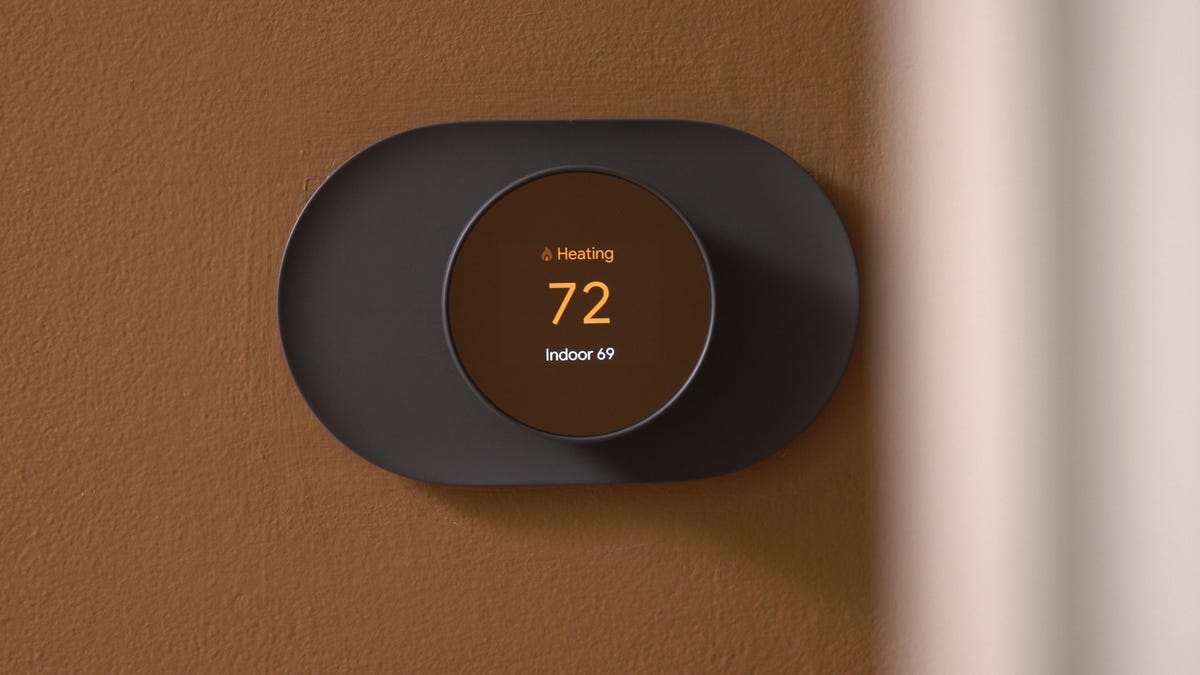Does Nest Thermostat Save Money? Unveiling the Truth
Yes, the Nest Thermostat can save money by optimizing energy usage and reducing heating and cooling costs. By intelligently learning and adjusting to your preferences and habits, it can help you save on your energy bills.
The Nest Thermostat has gained popularity for its ability to create a comfortable and energy-efficient home environment. With its smart features and advanced technology, many homeowners wonder if this popular device can save them money.
We will explore the Nest Thermostat’s potential to reduce energy consumption and lower heating and cooling expenses.
By understanding how this smart thermostat works and its unique features, you can make an informed decision about whether it is a worthy investment for your home. So, let’s dive in and discover if the Nest Thermostat is indeed a money-saving solution.

Credit: www.cnet.com
Introduction To Nest Thermostat
The Nest Thermostat is designed to help save money on energy bills by learning your schedule and preferences. It represents a significant advancement in the evolution of home thermostats, offering a sleek design and intuitive interface.
One of the key features of the Nest Thermostat is its ability to automatically adjust the temperature based on your habits and the time of day. This can lead to significant savings on heating and cooling costs over time.
Additionally, the Nest Thermostat can be controlled remotely via a smartphone app, allowing you to make adjustments even when you’re away from home. With its energy-saving features and convenient functionality, the Nest Thermostat is a popular choice for those looking to reduce their environmental impact and save money on utility bills.
Cost Versus Savings
The Nest Thermostat can save money by optimizing heating and cooling, leading to reduced energy costs. Learning your preferences and adjusting temperature settings, it helps to lower utility bills over time. Its energy-saving features make it a cost-effective investment for many households.
| Initial Investment | Long-Term Financial Benefits |
| The Nest Thermostat requires an initial investment but pays off in the long run due to its energy-saving features. | Energy efficiency leads to reduced utility bills and substantial long-term savings. |
Energy Consumption Insights
When it comes to energy consumption insights, understanding usage patterns is crucial. By adjusting habits for efficiency, you can save money on your energy bills. One way to achieve this is by using a Nest Thermostat, which can provide valuable data on your energy usage.
This data can help you identify opportunities to reduce consumption and make informed decisions about your energy usage. By taking advantage of the insights provided by a Nest Thermostat, you can optimize your energy usage and potentially lower your energy costs.
Smart Features For Smart Savings
Smart features in Nest Thermostat help you save money on energy bills. The device learns your schedule and adjusts the temperature accordingly. With the Auto-Away feature, it detects when you leave the house and sets the temperature to Eco mode.
This reduces energy consumption and saves you money. The Eco temperature can also be set manually when you are at home but want to save on energy. Nest Thermostat’s smart features make it easy for you to save money without compromising on your comfort.
| Smart Features | Savings |
|---|---|
| Learning Your Schedule | Reduces energy consumption |
| Auto-Away | Sets temperature to Eco mode |
| Eco Temperature | Manually set to save on energy |
Real Users’ Experiences
Nest Thermostat is known to save money according to real users’ experiences. With its smart features and energy-saving capabilities, users have reported significant reductions in their energy bills. Discover how Nest Thermostat can help you save money while keeping your home comfortable.
Case StudiesOne Nest Thermostat user reported an average energy savings of 10% to 12%, while another user saved over $1,000 in just two years. These case studies show that the Nest Thermostat can indeed save users money on their energy bills. Testimonials And ReviewsMany users have left positive reviews and testimonials about the Nest Thermostat, praising its ease of use and ability to save money. One user even reported that the Nest Thermostat paid for itself in just one year through energy savings. Overall, the Nest Thermostat has a strong reputation for helping users save money on their energy bills. |

Credit: m.youtube.com
Comparative Analysis With Traditional Thermostats
Comparative Analysis with Traditional Thermostats:
The Nest thermostat is a popular smart thermostat that is known for its ability to save energy and reduce electricity bills. However, it is important to weigh the pros and cons of this new technology against traditional thermostats.
One of the main advantages of the Nest thermostat is that it can learn your habits and preferences and automatically adjust the temperature according to your schedule. This feature can save you money and energy in the long run. On the other hand, traditional thermostats are simpler and less expensive to install and maintain.
Pros and Cons:
| Pros: | Cons: |
| – The Nest thermostat can learn your habits and preferences – It can save you money and energy in the long run |
– It is more expensive than traditional thermostats – It requires a Wi-Fi connection and a smartphone app to function |
| – Traditional thermostats are simpler and less expensive to install and maintain |
Break-even Point Calculation:
The break-even point for the Nest thermostat depends on several factors, including the size of your home, your heating and cooling needs, and your energy usage patterns. However, in general, the Nest thermostat can pay for itself in about two years or less.
This means that if you plan to stay in your home for more than two years, the Nest thermostat can be a wise investment that will save you money in the long run.
Environmental Impact
The Nest Thermostat not only saves money on energy bills but also has a positive environmental impact. By efficiently regulating heating and cooling systems, it reduces energy consumption and greenhouse gas emissions, making it an eco-friendly choice for homeowners.
| Environmental Impact |
|---|
|
By reducing your energy consumption, Nest Thermostat can significantly reduce your carbon footprint and help support sustainable living. According to Nest, users can save an average of 10-12% on heating bills and 15% on cooling bills. This translates to a reduction in carbon emissions of up to 1.2 tons per year. The thermostat also uses sensors to detect when no one is home, automatically adjusting the temperature to save energy. Additionally, Nest partners with energy companies to offer rebates and incentives for users who install and use their products, further encouraging sustainable living. |
Maximizing Your Nest’s Potential
Regular maintenance of your Nest thermostat is crucial for ensuring its optimal performance. Check the system’s settings and schedule to make sure they are adjusted for energy efficiency.
Additionally, clean the device regularly to prevent dust and debris from affecting its functionality. Consider installing a smart temperature sensor to maximize the thermostat’s capabilities. Finally, take advantage of energy-saving features such as the Eco mode and learning schedule to save on your energy bills.
The Verdict
Does Nest Thermostat Save Money? The answer ultimately depends on your usage habits and home setup. Is Nest Right for You? If you value convenience and are willing to invest in smart home technology, Nest could be a worthwhile addition.
Final Thoughts on Cost Savings While Nest can lead to energy savings, the actual amount will vary based on individual circumstances. It’s essential to weigh the initial cost against potential long-term benefits to determine if it’s a good fit for your home.

Credit: www.youngshomecomfort.com
Frequently Asked Questions
Will A Nest Thermostat Lower My Electric Bill?
Yes, a Nest thermostat can help lower your electric bill. By automatically adjusting the temperature based on your preferences and occupancy patterns, it optimizes energy usage. This can lead to significant savings over time.
What Are The Drawbacks Of A Nest Thermostat?
The drawbacks of a Nest thermostat include compatibility issues with older HVAC systems, occasional connectivity problems, and the need for a stable Wi-Fi connection. It may also have limited features compared to other smart thermostats. However, regular software updates aim to address these concerns and improve overall performance.
How Much Money Is Saved With Nest?
Nest helps save money on energy bills. The exact amount saved varies depending on factors like location and usage habits. By optimizing heating and cooling, Nest can reduce energy consumption, resulting in potential savings of hundreds of dollars per year.
Can You Save Money With Nest?
Yes, you can save money with Nest. Its energy-saving features help reduce electricity consumption and lower utility bills. Nest thermostats adjust temperature settings based on your preferences and occupancy patterns, optimizing energy usage. Additionally, Nest provides detailed energy usage reports to help you identify further cost-saving opportunities.
Conclusion
The Nest Thermostat has proven to be an effective and efficient way to save money on energy bills. With its smart features and learning capabilities, it optimizes temperature settings based on your preferences and occupancy patterns. Reducing unnecessary heating and cooling, helps lower energy consumption and ultimately, saves you money.
Investing in a Nest Thermostat can have long-term benefits for both your wallet and the environment.
- Nest Thermostat Fan Always On: Quick Fixes & Tips - September 1, 2024
- How Much to Install a Nest Thermostat? Smart Savings! - August 31, 2024
- Reset Nest Thermostat for New Owner: Quick Setup Guide - August 30, 2024
